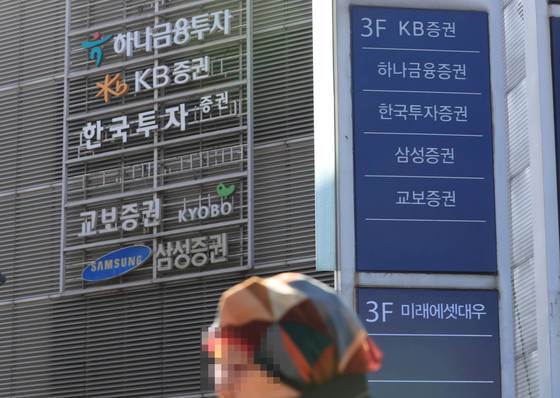Song Mo, 35, an 11-year-old employee invested in stocks for the first time in his life in September of last year. I bought 60 shares of Samsung Electronics with an extra 3.5 million won. Until then, I was only snooping on bank deposits and savings, and I wasn’t interested in investing in stocks. Then, after hearing the news that my colleagues at the company had fun with stocks, I decided to invest in the anxiety that’I’m the only one who can’t make money.’
Last month, I even created a stock account for my two-year-old daughter. I bought 5 shares of Samsung Electronics and 1 share of Hyundai Motor. Song said, “I made a stock account because I wanted to help my child financially if I left it for 20 to 30 years.” He even joined the ranks of’parent ants’.

The number of active stock trading accounts exceeded 40 million, recording a record high. A sign of a securities company is hung on the outer wall of a building in downtown Seoul. yunhap news
4,220,000 stock accounts’the largest ever’
It is truly the’national stock era’. The number of active stock trading accounts exceeded 40 million thanks to the stock investment fever of individual investors. Stocks have been established as a means of financial finance for the people, as’one account per person’ has become a reality. It is said that’if only two people get together, they talk about stocks’.
According to the Korea Financial Investment Association on the 25th, the number of active accounts for stock trading as of the 23rd reached a record high of 4,102,1075. As of the end of last month, the number of residents registered in Korea was 58.82 million, of which 43.12 million were over 20 years old. One per adult has a stock account.
On March 6, last year, when the stock market was fluctuating in the aftermath of a novel coronavirus infection (Corona 19), it exceeded 30 million, and increased 10 million in one year. Only 4.5 million accounts have been opened this year. Stock trading activity accounts refer to securities accounts with deposit assets of 100,000 won or more and have been traded at least once in six months. The increase in these accounts means that investors who have left their hands on stocks for a while have resumed trading or that new investors have increased.
Literally, the increase in’live and moving’ accounts is analyzed as a result of the rapid increase in’Jurini’ (stock + children) who entered the’Donghak Ant Movement’ after the Corona 19 incident last year. It became difficult to buy a house with only salary, and as it became difficult to increase wealth due to low interest rates, all of you were driven to the stock market. The enthusiasm for subscription to popular public offering stocks such as SK Bioscience also contributed to the increase in the number of account openings.

Stock trading activity accounts that are growing rapidly. Graphic = Reporter Kim Young-ok [email protected]
2030 Investors surge… Women Doubled in 4 Years
Of course, there are many cases where an investor has multiple accounts. Experts believe that an average of two or three accounts per person would have been held. Hwang Se-woon, a researcher at the Capital Market Research Institute, said, “It can be seen as reflecting changes in the market environment, such as the explosive increase in the number of investors interested in stocks exceeding 40 million accounts, as well as the increase in multiple accounts and minor accounts.”
According to the Korea Securities Depository, the number of individual investors who eliminated duplicate accounts was 910,7228 as of the end of last year. An increase of about 2.99 million people (48.9%) from the previous year. In particular, those in their 20s and 30s increased a lot. The number of people in their thirties increased to 1.18 million people, a surge of 740,000 in a year, and those in their twenties increased by 690,000 to 1.07 million. The number of minors under the age of 20 has more than doubled from 98,612 to 23,3710.
It is also noteworthy that the number of female investors has increased. The number of female ants reached 3.88 million, 8787, an increase of 1.47 million in a year. Compared to the end of 2016 (1.94 million), it doubled in four years. During the same period, the number of men increased from 2.93 million to 5.21 million, which is higher than the increase of 77.8% (2.28 million).
Reporter Hwang Eui-young [email protected]
![]()
